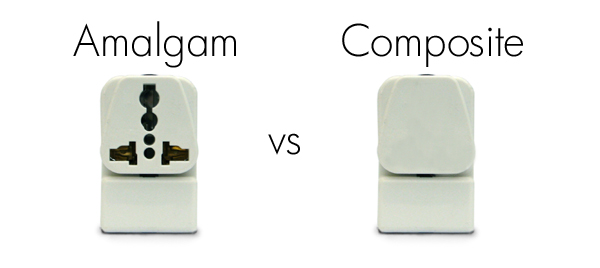 While the majority of dentists now use mercury-free composite fillings, some continue to use dental amalgam, also known as "silver fillings". Over the years, concerns have been raised about the use of amalgam because it contains mercury. Here are answers to some common patient questions about dental fillings.
While the majority of dentists now use mercury-free composite fillings, some continue to use dental amalgam, also known as "silver fillings". Over the years, concerns have been raised about the use of amalgam because it contains mercury. Here are answers to some common patient questions about dental fillings.
What is in a mercury-metal filling?
Metal Fillings are composed of mercury, tin, silver (not much), and copper. The actual mercury content is between 43 and 54% mercury when placed. They are not chemically bonded to the tooth as tooth colored, or composite, filling material is. It is the consistency of wet sand when it is placed in a tooth and is only held in by undercutting the tooth structure so it is wedged into place. As time goes by, the filling breaks down in three ways:
- The release of mercury vapor in the mouth lessens the strength, longevity, and resilience of the filling.
- Corrosion of the surface of the filling due to the persistently wet environment. This process is similar to rusting iron.
- Attrition of the surface and edges of the filling from eating, clinching, and grinding cause the edges to be tattered and irregular, causing food traps.
How do mercury-metal fillings work?
When a tooth is prepared mercury-metal filling, healthy portions of the tooth are undercut in order for the filling to stay in the tooth. Essentially, it relies on mechanical retention (it is wedged into place), rather than having a chemical bond and seal to the tooth such as with a tooth colored, or composite) filling.
[caption id="attachment_1586" align="aligncenter" width="584"]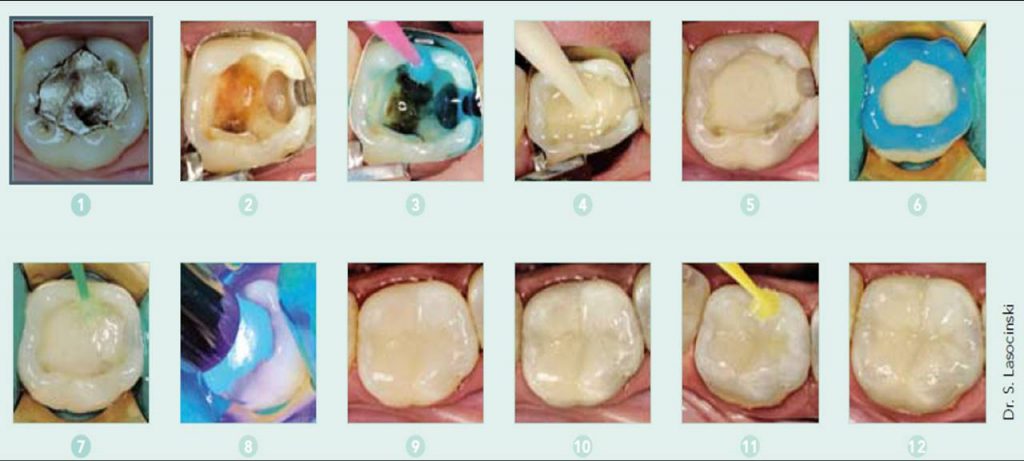 What you can't see: decay often occurs underneath amalgam fillings, and it doesn't always present on x-rays. By removing "silver fillings" and replacing with white composite resin, your dentist will accurately assess any future damage and treat with tiny fillings versus more indepth restorations like crowns, root canals, and/or dental implants.[/caption]
What you can't see: decay often occurs underneath amalgam fillings, and it doesn't always present on x-rays. By removing "silver fillings" and replacing with white composite resin, your dentist will accurately assess any future damage and treat with tiny fillings versus more indepth restorations like crowns, root canals, and/or dental implants.[/caption]
 What you can't see: decay often occurs underneath amalgam fillings, and it doesn't always present on x-rays. By removing "silver fillings" and replacing with white composite resin, your dentist will accurately assess any future damage and treat with tiny fillings versus more indepth restorations like crowns, root canals, and/or dental implants.[/caption]
What you can't see: decay often occurs underneath amalgam fillings, and it doesn't always present on x-rays. By removing "silver fillings" and replacing with white composite resin, your dentist will accurately assess any future damage and treat with tiny fillings versus more indepth restorations like crowns, root canals, and/or dental implants.[/caption]
How do these metals affect the tooth?
Metal mercury fillings, without exception, microscopically expand and contract over time (just as mercury does in a thermometer). This causes the enamel of the tooth to fracture over time. Enamel fracture leads to tooth fracture. The more damaged a tooth is, the more expensive it is to repair. The expansion and contraction compromises the seal between the filling and the tooth, allowing cavity causing bacteria to colonize the area below the surface of the filling between the filling and the tooth, eventually causing new cavities.
Cavities beside metal fillings likely grow more slowly than some others because the metals in the filling kill bacteria through exposure. But eventually, the bacteria grow in number enough to overpower the effects of the metals. These new cavities are often difficult to recognize on routine dental x-rays because the metal distorts the view immediately around the filling. But if the margin of the filling is not smooth and perfect, then the cavity forming process has already begun. The new cavities develop over time, possibly causing the tooth the break or facilitating the need for a Root Canal Procedure or an Extraction.
How do metal filings affect your body and overall health?
It has been demonstrated through extensive studies that the amount of mercury released from fillings each day is considerably lower than the amount normally absorbed from the rest of our environmental sources including air, water, and foods. Other studies have demonstrated safety for patients and dental professionals in the removal of amalgam fillings.
[caption id="attachment_1590" align="aligncenter" width="950"]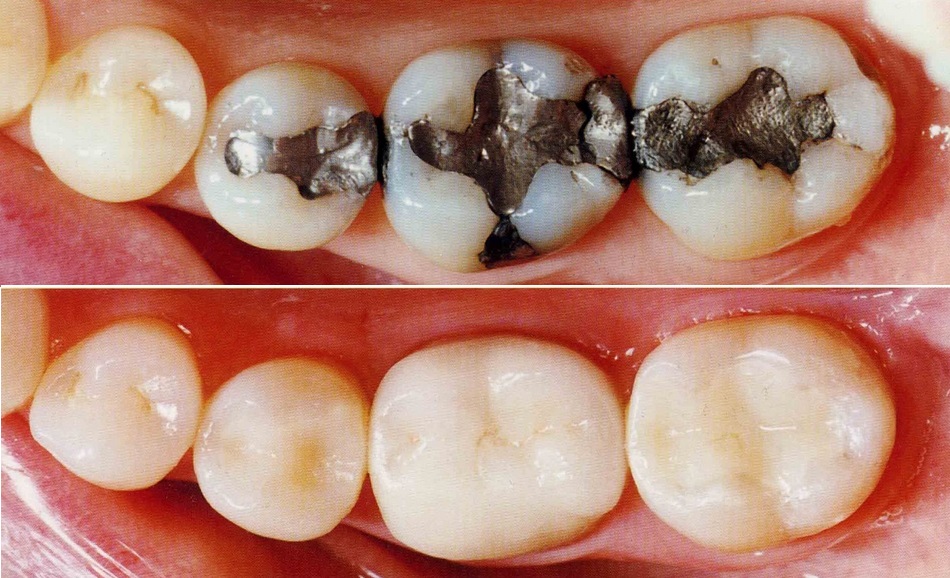 Amalgam v/s Composite Fillngs[/caption]
Amalgam v/s Composite Fillngs[/caption]
 Amalgam v/s Composite Fillngs[/caption]
Amalgam v/s Composite Fillngs[/caption]
What do we believe?
We do not believe profound evidence exists showing the mercury is affecting the overall health of most of the individuals who have them. We also find it compelling that if you could actually suffer through reading all of the metal filling related regulations, according to the FDA, EPA, ADA, state governments, and local municipalities, there are only two places where it is acceptable for metal-mercury filling material to exist; Hazardous Waste Disposal, and your mouth. Think about that.
However, we do know with certainty that the amalgams are incredibly detrimental to the health of the tooth. So generally, we believe that if metal fillings are present, they should be removed and replaced with a restoration, porcelain or composite, which will restore the strength of the tooth to last in the long term.
BOTTOM LINE: we remove amalgam fillings because we know (with 99% accuracy) that if the margins are not sealed and they are of a certain age, there is decay destroying the tooth structure below the filling.







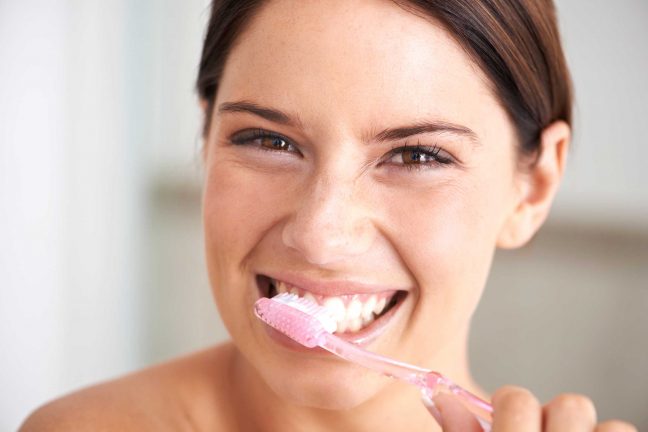 We were recently reading a Spear Digest post by Imtiaz Manji where contributor Dr. Gary DeWood stated, “remember, dental insurance doesn’t exist.”
What does this mean, considering all the energy and resources the average practice devotes to working with patients’ dental plans, dental insurance sure feels like a reality to most dentists?
The point Gary is making is that dental insurance is quite simply not insurance, in the true sense of the word. It’s not like home insurance or auto insurance, where you pay a premium in exchange for blanket coverage in the event of losses or expenses. If dental insurance were really insurance, patients would submit their claims for all necessary work that needed to be done and be fully reimbursed (minus an agreed-upon deductible).
But that’s not how dental plans work. What dental plans offer are benefits – a limited allowance to go towards funding dental care costs, which is a different thing. These are indeed useful and valuable benefits to patients and it is perfectly understandable that dental practices would want to help patients manage and maximize their benefits. But it is also important that patients are not fooled by the term “insurance” to the point where they have false expectations. The best advice seems that dental practices should not use the word “coverage” when talking about dental plan benefits.
Similarly, we in the dental community, as Gary keeps reminding us, should stop thinking in terms of “insurance.” That’s a word that dental plan providers use. It’s a mindset trap, one we should not fall into.
Great dentistry comes at a cost. If that cost can be offset by a patient's benefit plan, great. But we can’t allow ourselves – or patients – to let these allowances govern treatment decisions. Because that’s what they are: allowances, benefits, economic supplements. It is not insurance. Because dental insurance does not exist.
source:
We were recently reading a Spear Digest post by Imtiaz Manji where contributor Dr. Gary DeWood stated, “remember, dental insurance doesn’t exist.”
What does this mean, considering all the energy and resources the average practice devotes to working with patients’ dental plans, dental insurance sure feels like a reality to most dentists?
The point Gary is making is that dental insurance is quite simply not insurance, in the true sense of the word. It’s not like home insurance or auto insurance, where you pay a premium in exchange for blanket coverage in the event of losses or expenses. If dental insurance were really insurance, patients would submit their claims for all necessary work that needed to be done and be fully reimbursed (minus an agreed-upon deductible).
But that’s not how dental plans work. What dental plans offer are benefits – a limited allowance to go towards funding dental care costs, which is a different thing. These are indeed useful and valuable benefits to patients and it is perfectly understandable that dental practices would want to help patients manage and maximize their benefits. But it is also important that patients are not fooled by the term “insurance” to the point where they have false expectations. The best advice seems that dental practices should not use the word “coverage” when talking about dental plan benefits.
Similarly, we in the dental community, as Gary keeps reminding us, should stop thinking in terms of “insurance.” That’s a word that dental plan providers use. It’s a mindset trap, one we should not fall into.
Great dentistry comes at a cost. If that cost can be offset by a patient's benefit plan, great. But we can’t allow ourselves – or patients – to let these allowances govern treatment decisions. Because that’s what they are: allowances, benefits, economic supplements. It is not insurance. Because dental insurance does not exist.
source: 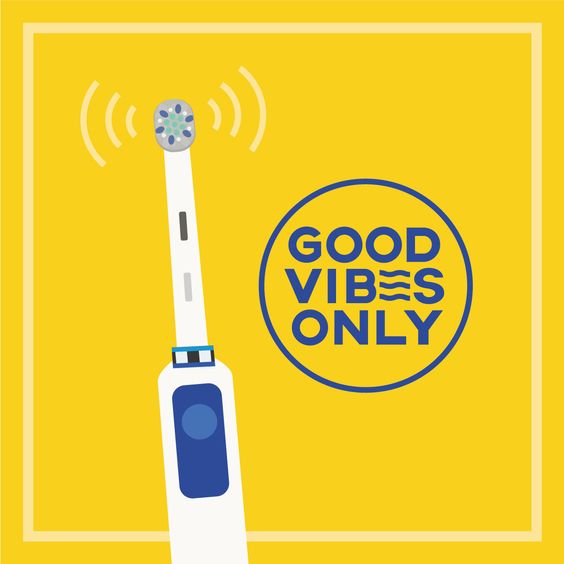 photo via Pinterest[/caption]
photo via Pinterest[/caption]
 Are You Being Treated with Chemotherapy for Cancer?
Are You Being Treated with Chemotherapy for Cancer?